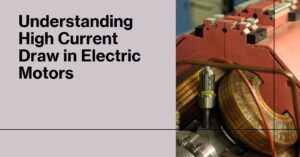Circuit breakers play a vital role in safeguarding electric motors and electrical systems from potential damage.
When a breaker trips, it interrupts the current flow to protect the motor and prevent hazards such as electrical fires.
Understanding the common causes of electric motor breaker tripping can help identify the underlying issues and implement appropriate solutions.
As a short answer, the electric motor can trip the breaker due to reasons such as overload, short circuit, ground fault, high inrush current, motor overheating, faulty motor or equipment, faulty circuit breaker, or a faulty power cable.
In this article, we will explore the main factors that can lead to breaker tripping and provide insights on troubleshooting techniques.
Table of Contents
I. Overload
An overload occurs when the motor draws more current than its rated capacity due to an excessive load or a jammed/stuck load. This can strain the motor and trip the breaker as a protective measure.
- Excessive Load: Motors are designed to handle specific loads. Operating beyond this capacity can cause the motor to overwork, leading to excessive current draw and breaker tripping. Ensure that the motor is appropriately sized for the intended load.
- Jammed or Stuck Load: If the load becomes jammed or stuck, the motor will exert additional effort to overcome the obstruction, resulting in an increased current draw. Regular maintenance and prompt resolution of any mechanical issues can prevent such situations.
II. Short Circuit
Short circuits occur when the motor’s live wire comes into direct contact with the ground or neutral wire, causing a sudden surge in current and subsequent breaker tripping.
- Damaged Insulation: Worn-out or damaged insulation can lead to exposed wires and increased risk of short circuits. Regular inspections and repairs of insulation are crucial to prevent such incidents.
- Loose Connections: Loose or improperly connected wires can create intermittent or poor electrical contacts, increasing the likelihood of short circuits. Periodically check and tighten all electrical connections to ensure secure and reliable connections.
- Electrical Faults: Electrical faults such as damaged components, faulty switches, or compromised wiring can create conditions conducive to short circuits. Conduct thorough inspections and enlist the expertise of a qualified electrician to identify and rectify any electrical faults.
III. Ground Fault
Ground faults occur when the motor’s live wire comes into contact with a grounded surface or conductor. These faults can be hazardous and cause the breaker to trip.
Damaged Insulation: Like short circuits, damaged insulation increases the risk of ground faults. Inspect the insulation regularly and replace any damaged sections promptly.
Faulty Wiring: Improperly installed or deteriorated wiring can create opportunities for ground faults. Ensure that wiring is correctly installed, and replace any damaged or frayed wires immediately.
Improper Grounding: Inadequate or improper grounding of the motor can contribute to ground faults. Follow electrical codes and guidelines to establish proper grounding connections and reduce the risk of ground faults.
IV. High Inrush Current
When an electric motor starts, it requires a higher current to overcome initial inertia and set the rotor in motion. This initial surge in current, known as inrush current, can trip the breaker if it exceeds its capacity.
- Initial Inertia: Motors require more current to initiate motion due to the resistance posed by their own weight or the load they are driving. Ensure that the motor’s rated inrush current is within the breaker’s limits to prevent tripping.
- Starting Current Surge: The moment the motor receives power, there is a temporary surge in current. Select and configure appropriate motor starters or soft-start devices to manage this surge and avoid excessive current draw that could trip the breaker.
V. Motor Overheating
Motor overheating can lead to a breaker tripping as a protective measure against further damage. Several factors can contribute to motor overheating:
- Prolonged Operation: Continuous operation without adequate breaks for cooling can cause the motor to overheat. Implement regular maintenance schedules and consider installing temperature monitoring devices to ensure optimal operating conditions.
- Inadequate Cooling: Insufficient ventilation, blocked cooling fans, or malfunctioning cooling systems can hinder the motor’s ability to dissipate heat effectively. Keep the motor and its surroundings clean and free from obstructions, and repair or replace any faulty cooling components.
- Excessive Ambient Temperature: High ambient temperatures can put additional strain on the motor and impede heat dissipation. Consider implementing measures such as insulation, heat shielding, or relocating the motor to a cooler environment to mitigate overheating risks.
For more information read my comprehensive article Motor Temperature Rise (Causes and Limits)
VI. Faulty Motor or Equipment
Internal issues or malfunctions within the motor or associated equipment can trigger breaker tripping. Regular maintenance and inspections can help identify and resolve such problems promptly.
- Internal Faults: Shorted windings, damaged bearings, or other internal issues can cause the motor to draw excessive current and trip the breaker. Conduct regular inspections and testing to identify and rectify these faults.
- Malfunctioning Motor Control Circuitry: Faulty control circuitry, such as damaged relays or sensors, can lead to erratic motor behavior and breaker tripping. Thoroughly examine the motor control circuitry and repair or replace any faulty components.
- Issues with Associated Equipment: Problems with equipment connected to the motor, such as damaged pumps or mechanical components, can indirectly cause breaker tripping. Assess the condition of all associated equipment and repair or replace any malfunctioning parts.
VII. Faulty Circuit Breaker
Even if there are no issues with the motor or the electrical system, a faulty circuit breaker can trip unexpectedly. It is essential to recognize signs of a faulty breaker and take appropriate action.
- Wear and Tear: Circuit breakers can deteriorate over time due to regular use, causing them to trip more easily. Consider regular inspections and replacements to ensure optimal breaker performance.
- Reduced Sensitivity: A weakened or desensitized breaker may trip at lower currents than intended. If you suspect a faulty breaker, consult a qualified electrician to perform diagnostic tests and replace the breaker if necessary.
Read also my article: When Breakers Go Bad: The Top Symptoms and Solutions.
VIII. Faulty Power Cable
A damaged or faulty power cable can disrupt the flow of current, leading to breaker tripping.
- Damaged Insulation: Worn-out or damaged insulation on the power cable can increase the risk of short circuits or ground faults. Regularly inspect the cable for any signs of wear or damage and replace it if needed.
- Improper Electrical Connections: Loose or poorly connected power cable terminals can cause intermittent interruptions in the current flow, triggering breaker trips. Ensure all electrical connections are secure and properly tightened.
- Shorts or Disruptions: Power cables that have been compromised by cuts, abrasions, or accidental damage can result in short circuits or interruptions in the electrical supply. Thoroughly inspect the cable and replace it if any faults are detected.
Conclusion:
Understanding the common causes of electric motor breaker tripping is crucial for maintaining the safety and efficiency of electrical systems.
By identifying the underlying issues such as overloads, short circuits, ground faults, high inrush currents, motor overheating, faulty motor or equipment, faulty circuit breakers, and faulty power cables, appropriate troubleshooting steps can be taken to prevent unnecessary tripping and ensure smooth motor operation.
Regular maintenance, prompt repairs, and professional assistance from qualified electricians are vital in effectively addressing and resolving these issues to maintain optimal performance and prolong the lifespan of electric motors and associated equipment.
Don’t Leave Empty-Handed!
Install my Free Android App on Google Play:
Electrical Cables Most Common Tables “Cables Tables”
And, my Electrical Calculations App “Fast Electrical Calculator”
Discover more great content by subscribing to My channel
Looking to stay ahead of the game in the world of electrical engineering? Subscribe to my YouTube channel and gain access to exclusive content you won’t find anywhere else!
The staff I recommend
(Amazon Affiliate Links to products I believe are high quality):
- Economy 120 Volt/60Hz AC Power Source – Step-Down Voltage & Frequency Converters 1800W
- UNI-T Digital Multimeter Tester UT139C
- 50-Amp Extension Cord for RV “100ft”
- Voltage Stabilizer 110/220v
- Hair Dryer “best selling“
- TOSHIBA EM131A5C-BS Countertop Microwave Ovens
Disclaimer: This contains affiliate links to Amazon products. I may earn a commission for purchases made through these links.



